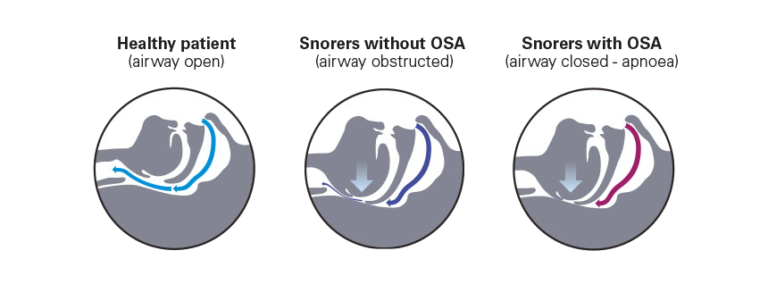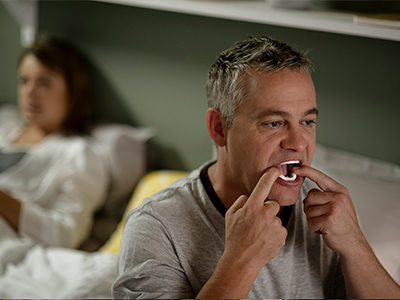Snoring can have a disruptive effect on your patients’ lives. They’re
often not the first to realise they have a problem: rather, it’s their bed
partner who comments. In a French epidemiologic study conducted
in 2007 on 850 participants aged 22 to 66, the prevalence of regular
snoring was 34.6%.1
95% of snorers say that their snoring bothers their partner or their family.1 Of course, it plays havoc with their sleep as well, leaving them feeling tired, listless, even grumpy.
Snorers are 1.6 times more likely to develop arterial hypertension within 4 years2 of beginning to snore. There are risks of other cardiovascular diseases as well.3
Both snoring and obstructive sleep apnea (OSA) have a common origin: the obstruction of the upper airway caused by the relaxation of muscles controlling the soft palate and tongue. In snorers without OSA, the airway is obstructed, but not collapsed, though there are flow limitations. In snorers with OSA, there is a partial or complete collapse of the airway, leading to either:

Several factors can increase snoring intensity: fatigue, excess weight, sleeping on the back, and drinking alcohol before going to bed are all conducive to loud snoring. People with enlarged tonsils, an enlarged tongue or excess weight around the neck are also prone to snoring. Even structural reasons like the shape of one’s nose or jaw can cause snoring.
Snoring is also the primary4 symptom of obstructive sleep apnea (OSA), which is the most common form of sleep-disordered breathing (SDB). Snoring and sleep apnea are linked at an alarming rate — 3 in 10 men and nearly 2 in 10 women who are habitual snorers also suffer from some degree of obstructive sleep apnea.5
Clinical studies show that people with untreated sleep apnea run greater health risks:

more risk of cardiovascular accidents3

more likely to develop coronary diseases6

more likely to develop arterial hypertension7

more likely to have a road accident8
Always make sure you screen your patients for OSA. A correct diagnosis is essential to choosing the most appropriate treatment option. Patients who are throat snorers or who have a mild or moderate level of AHI (less than 30) are candidates for a mandibular repositioning device.

ResMed has treatment options for throat snorers who have sleep apnea, as well as throat snorers who don’t.

There are three types of sleep apnea: Obstructive Sleep Apnea (OSA), Central Sleep Apnea (CSA) and mixed or complex sleep apnea. Each type has distinctive characteristics that enable diagnosis.

ResMed gives you the tools to screen your patients for sleep-disordered breathing, request a sleep study, and get them diagnosed.
Teculescu D & al. Habitual snoring. Prevalence and risk factors in a sample of the French male population. Revue des Maladies Respiratoires, 2007 Mar, 24(3 Pt 1):281-7.
Teculescu D & al. Habitual snoring. Prevalence and risk factors in a sample of the French male population. Revue des Maladies Respiratoires, 2007 Mar, 24(3 Pt 1):281-7.
A +A Healthcare study undertaken with 95 patients who wore Narval CC (Equinoxe in France) in 2011.
Peepard T. Prospective study of the association between sleep-disordered breathing and hypertension. N Engl J Med, 342 (2000), pp. 1378-1384.
Marin JM. Long-term cardiovascular outcomes in men with obstructive sleep apnea-hypopnoea with or without treatment with continuous positive airway pressure: an observational study. Lancet. 2005 Mar 19 25;365(9464):1046-53.
Meslier N, Racineux JL. Snoring and high-resistance syndrome. Rev Mal Respir 2004; 21 : 2S35-2S42. (French)
Young T et al. The occurrence of sleep-disordered breathing among middle-aged adults. N Engl J Med 1993; 328(17):1230–5.
Peker Y, Carlson J, Hedner J. Increased incidence of coronary artery disease in sleep apnea: a long-term follow-up. Eur Respir J. 2006 Sep;28(3):596-602.
Ellen et al. Systematic review of motor vehicle crash risk in persons with sleep apnea. J Clin Sleep Med. 2006 Apr 15;2(2):193-200.
McNamara SG, Cistulli PA, Sullivan CE, Strohl KP. Clinical aspects of sleep apnea. In: Saunders NA, Sullivan CE, editors. Sleep and breathing: lung biology in health and disease. 2nd ed. New York: Marcel Dekker; 1994: 337-61.